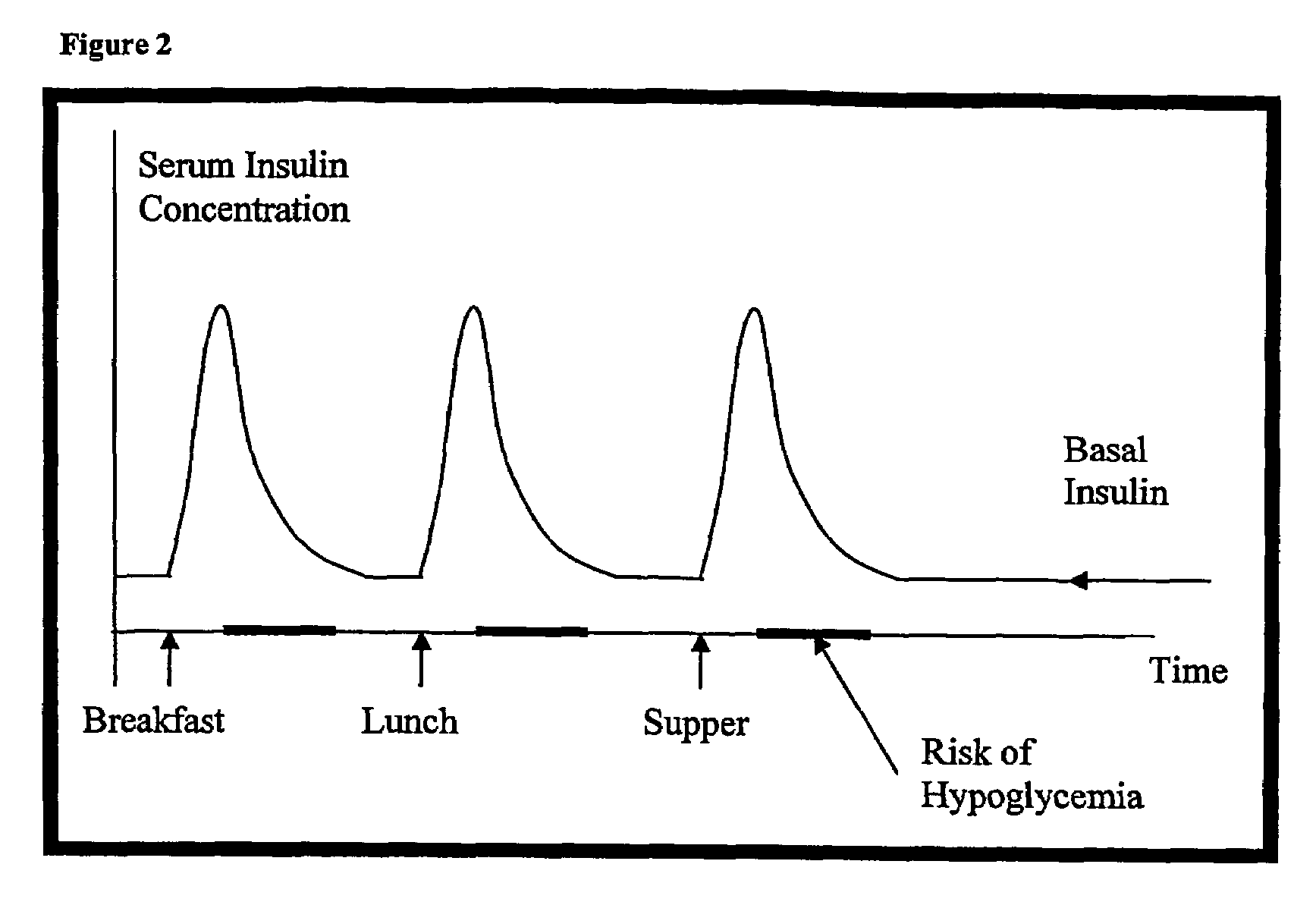Compositions and methods for the prevention and control of insulin-induced hypoglycemia
a technology of insulin-induced hypoglycemia and composition, which is applied in the field of biology, pharmacology, medicine, can solve the problems of inability to detect and detect endogenous insulin levels, and inability of patients with diabetes to accurately sense low blood glucos
- Summary
- Abstract
- Description
- Claims
- Application Information
AI Technical Summary
Benefits of technology
Problems solved by technology
Method used
Image
Examples
example 1
Co-administration of Glucagon Parenterally and Insulin for the Control of Diabetes and Prevention of Hypoglycemia
[0043]The glucagon currently available in the North American market is human glucagon of rDNA origin produced by Eli Lilly & Co or Bedford Labs (Novo). Four brand names are known, these being: Glucagon Diagnostic Kit (Lilly); Glucagon Emergency Kit (Lilly); Glucagon Emergency Kit for Low Blood Sugar (Lilly); and GLUCAGEN (Bedford Labs).
[0044]Novo produces glucagon under its own name outside of North America. Novo produces its glucagon in yeast and Lilly produces its glucagon in E. coli. The following examples illustrate practice of the methods of the present invention using such commercially available glucagons and insulins administered via a variety of routes.
[0045]The Lilly glucagon is typically provided in kit form. The glucagon within the kit is in the form of a powder within a sterile vial with a standard rubber-sealed neck. The vial contains a mixture of 1 mg of lyo...
example 2
Co-administration of Glucagon by Pump and Insulin for the Control of Diabetes and Prevention of Hypoglycemia
[0070]Insulin can be administered by pump in accordance with the methods of the present invention. There are a number of pumps commercially available (or soon to be available) in the US market and elsewhere that are suitable for use in the present methods. These include but are not limited to:[0071]ANIMAS IR-1000)[0072]DELTEC (Cozmo pump)[0073]DISETRONIC (H-TRONplus and D-TRONplus)[0074]LIFESCAN & DEBIOTECH (MEMS Insulin Pump in development)[0075]MEDTRONIC MINIMED (PARADIGM Insulin Pump and 508 Insulin Pump)[0076]MEDTRONIC MINIMED (2007 Implantable Insulin Pump System (EU only))
[0077]When both the insulin and the glucagon are to be administered by pump (from separate reservoirs), a number of configurations can be employed in the practice of the present invention. Typical configurations are:[0078](1) A single device with a single pump and two reservoirs (for dual reservoir pump...
example 3
Co-administration of Glucagon Transdermally and Insulin for the Control of Diabetes and Prevention of Hypoglycemia [Including Patch and Topical Cream]
[0106]The use of transdermal patches for the delivery of therapeutic drugs is increasingly more common. Patches provide a non-invasive and easy method of delivering some drugs to the bloodstream. Nicotine and hormone replacement therapies are perhaps the best known uses of this technology. One of the characteristics of drug delivery by transdermal patch is that the rate of delivery is typically constant and persists for a long period of time (as long as the patch is worn). This characteristic has proven beneficial in the area of pain management (FENTANYL) and nicotine replacement therapy, in which long duration flat profiles are ideal. This characteristic makes the transdermal patch suitable for basal replacement of insulin or glucagon. See PCT patent publication No. WO0243566, incorporated herein by reference.
[0107]Fast-acting patches...
PUM
| Property | Measurement | Unit |
|---|---|---|
| weight | aaaaa | aaaaa |
| pH | aaaaa | aaaaa |
| pH | aaaaa | aaaaa |
Abstract
Description
Claims
Application Information
 Login to View More
Login to View More - R&D
- Intellectual Property
- Life Sciences
- Materials
- Tech Scout
- Unparalleled Data Quality
- Higher Quality Content
- 60% Fewer Hallucinations
Browse by: Latest US Patents, China's latest patents, Technical Efficacy Thesaurus, Application Domain, Technology Topic, Popular Technical Reports.
© 2025 PatSnap. All rights reserved.Legal|Privacy policy|Modern Slavery Act Transparency Statement|Sitemap|About US| Contact US: help@patsnap.com



